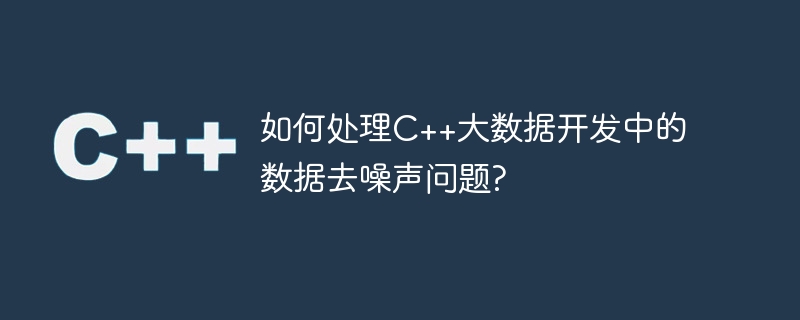

How to deal with the problem of data denoising in C big data development?
Introduction:
In the era of modern technology and the Internet, the generation and development of data Application has become an important task. The processing of big data has become one of the key topics in various industries. However, accurate analysis and application of these data becomes difficult due to the possible presence of noise in the source and transmission process of the data. This article will introduce methods and techniques for dealing with data denoising problems in C big data development, and provide corresponding code examples.
1. Introduction to the problem of data denoising
In the process of big data development, data denoising is a very important issue. Noise refers to random or non-random interference signals introduced during the data collection and transmission process. These interference signals may come from sensor errors, data loss in the network, or malicious attacks. The presence of noise will lead to inaccuracies in subsequent analysis and application of data. Therefore, some methods need to be adopted to deal with the noise in the data in big data development.
2. Outlier detection
Outliers are observations that are significantly different from other observations in the data. Outliers may be caused by measurement equipment failure, data sampling errors, or data entry errors. In big data, the presence of outliers may greatly affect the training of the model and the accuracy of the results. Therefore, detecting and processing outliers is an important step in data denoising.
The following is a sample code for an outlier detection algorithm implemented in C:
#include <iostream>
#include <vector>
#include <algorithm>
double detectOutlier(std::vector<double> data) {
std::sort(data.begin(), data.end());
double q1 = data[data.size() / 4];
double q3 = data[data.size() / 4 * 3];
double iqr = q3 - q1;
double upperBound = q3 + 1.5 * iqr;
double lowerBound = q1 - 1.5 * iqr;
for (auto d : data) {
if (d > upperBound || d < lowerBound) {
return d;
}
}
return -1;
}
int main() {
std::vector<double> data = {1.2, 2.1, 3.5, 4.0, 5.1, 6.2, 7.3, 100.0};
double outlier = detectOutlier(data);
if (outlier != -1) {
std::cout << "Detected outlier: " << outlier << std::endl;
} else {
std::cout << "No outlier detected." << std::endl;
}
return 0;
}The above code implements a simple outlier detection algorithm. First, we sort the data and calculate the quartiles q1 and q3 of the data, then calculate the interquartile range iqr, and finally define upper and lower bounds to determine whether it is an outlier.
3. Smoothing filtering
Smoothing filtering is a commonly used data denoising method. Smoothing filtering reduces the impact of noise by removing high-frequency components from the data, resulting in a smoother signal.
The following is a sample code for a smoothing filtering algorithm implemented in C:
#include <iostream>
#include <vector>
std::vector<double> smoothFilter(std::vector<double> data, int windowSize) {
std::vector<double> result(data.size(), 0.0);
int halfWindow = windowSize / 2;
for (int i = halfWindow; i < data.size() - halfWindow; i++) {
double sum = 0.0;
for (int j = i - halfWindow; j <= i + halfWindow; j++) {
sum += data[j];
}
result[i] = sum / windowSize;
}
return result;
}
int main() {
std::vector<double> data = {1.0, 2.0, 4.0, 3.0, 5.0};
int windowSize = 3;
std::vector<double> result = smoothFilter(data, windowSize);
std::cout << "Original data: ";
for (auto d : data) {
std::cout << d << " ";
}
std::cout << std::endl;
std::cout << "Smoothed data: ";
for (auto r : result) {
std::cout << r << " ";
}
std::cout << std::endl;
return 0;
}The above code implements a simple smoothing filtering algorithm. The algorithm performs sliding averaging on the data based on the moving window, and uses the average value to replace each element in the original data to achieve the purpose of smooth filtering.
Summary:
Data denoising is a very important issue in the big data development process. This article introduces methods and techniques for dealing with data denoising problems in C big data development, and provides corresponding code examples. Outlier detection and smoothing filtering are two commonly used data denoising methods. Developers can choose the appropriate method to deal with the noise in the data according to specific needs. By properly processing and cleaning data, the accuracy and reliability of data can be maximized, allowing for more precise data analysis and applications.
The above is the detailed content of How to deal with the problem of data denoising in C++ big data development?. For more information, please follow other related articles on the PHP Chinese website!
 What are the four big data analysis tools?
What are the four big data analysis tools?
 What are the differences between c++ and c language
What are the differences between c++ and c language
 Recommended learning order for c++ and python
Recommended learning order for c++ and python
 Cost-effectiveness analysis of learning python and c++
Cost-effectiveness analysis of learning python and c++
 Is c language the same as c++?
Is c language the same as c++?
 Which is better to learn first, c language or c++?
Which is better to learn first, c language or c++?
 The difference and connection between c language and c++
The difference and connection between c language and c++
 C++ software Chinese change tutorial
C++ software Chinese change tutorial




